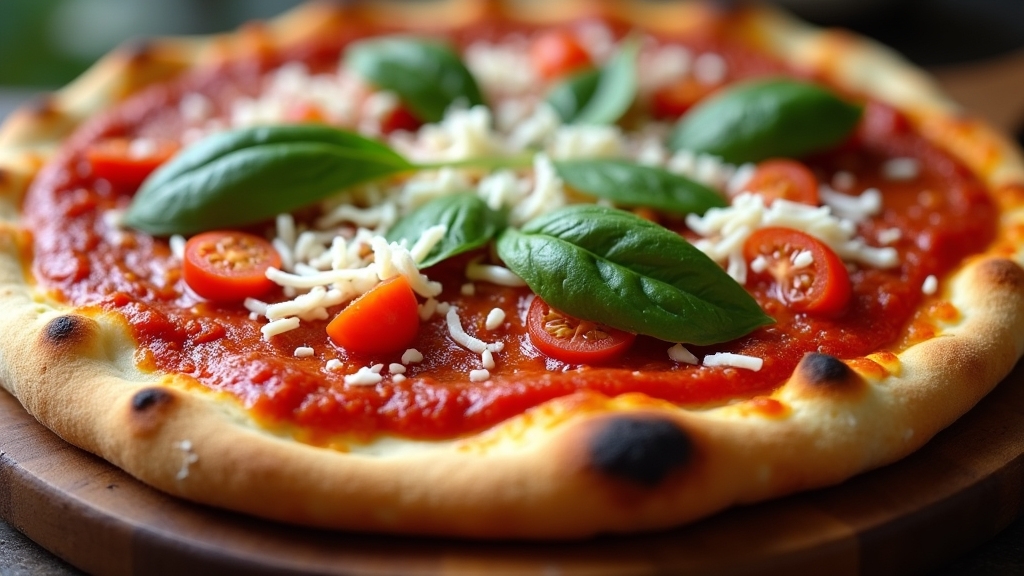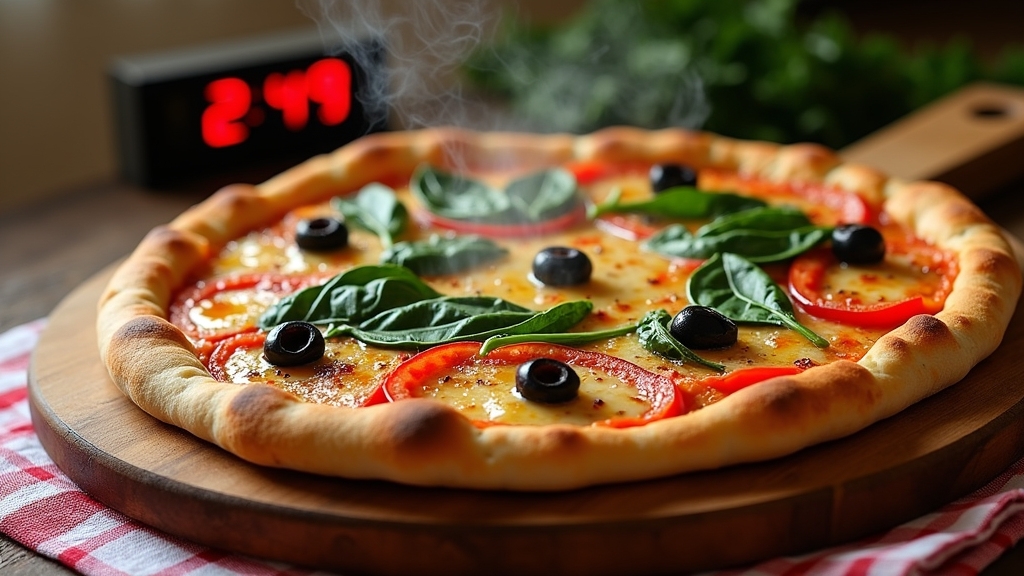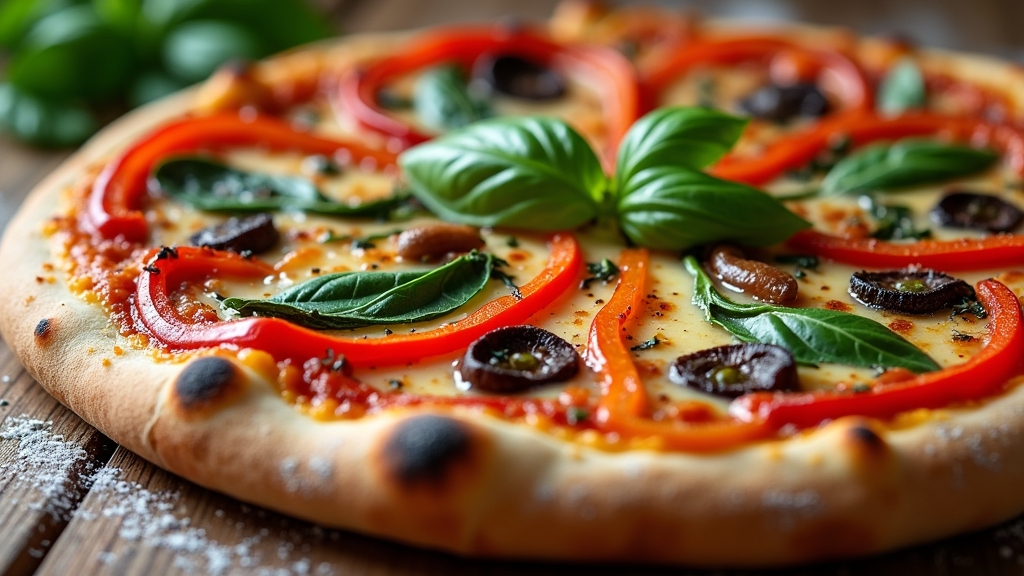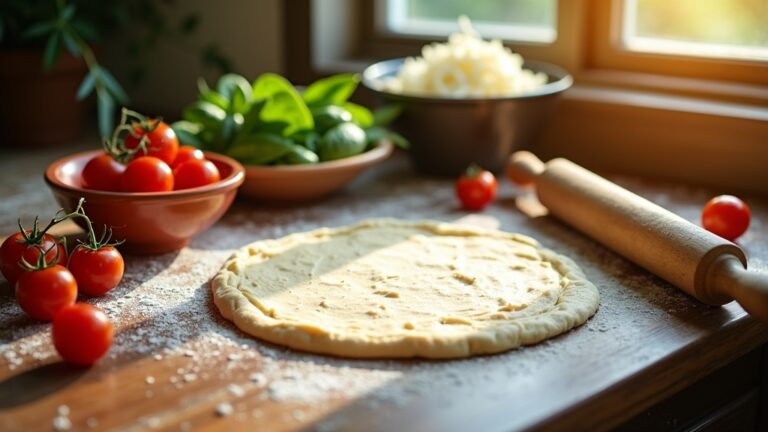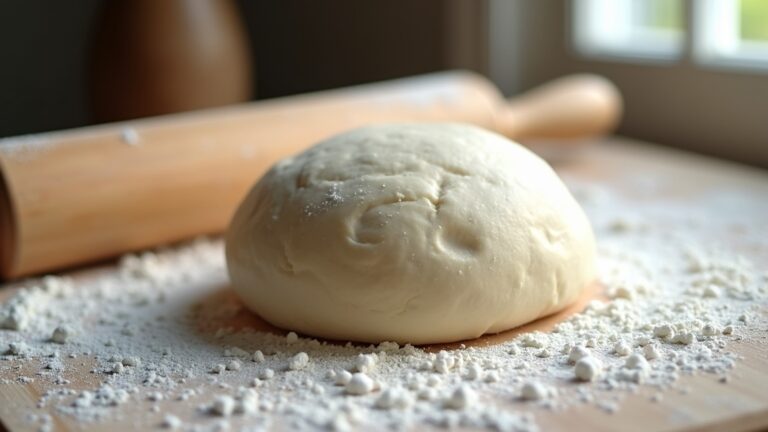Vegetable Pizza Recipe
If you’re craving a delicious and colorful vegetable pizza, I’ve got the perfect recipe for you! Start by preheating your oven to 475°F, then spread your favorite sauce on a crust of your choice. Load it up with vibrant veggies like bell peppers, spinach, and mushrooms, sprinkle with herbs, and bake for 12-15 minutes until golden and bubbly. Let it cool slightly before slicing. Trust me, every bite will be packed with flavor and goodness—let’s explore more exciting toppings!
Contents
History
When I think about the history of vegetable pizza, I can’t help but marvel at its evolution from a humble dish to a beloved favorite. Its Italian origins date back to the late 19th century, when fresh ingredients were artfully combined atop a simple dough. Originally a blank canvas for seasonal produce, vegetable pizza began to gain popularity as pizza evolved beyond its rustic roots. As culinary innovation surged, chefs experimented with diverse toppings, elevating the classic to new heights. Today, vegetable pizza showcases vibrant colors and bold flavors, reflecting a commitment to health and creativity. This delightful transformation not only honors tradition but also embraces modern tastes, making vegetable pizza a staple in kitchens around the world.
Recipe
Vegetable pizza is a delightful and healthy twist on the traditional pizza that everyone can enjoy. Packed with colorful vegetables and topped with your favorite cheese, this dish not only satisfies your cravings but also provides a nutritious option for any meal. Whether you’re hosting a weekend gathering or just looking for a quick dinner idea, this vegetable pizza is sure to impress your family and friends.
Making vegetable pizza at home is easier than you might think. You can customize it with your favorite vegetables, spices, and sauces. The crust can be made from scratch or purchased pre-made for convenience. This recipe will guide you through creating a delicious vegetable pizza that is bursting with flavor and goodness. Let’s get started on this fun and tasty cooking adventure!
Ingredients:
- 1 pre-made pizza crust (or homemade crust)
- 1/2 cup pizza sauce
- 1 cup shredded mozzarella cheese
- 1 bell pepper, sliced
- 1 small zucchini, thinly sliced
- 1 cup mushrooms, sliced
- 1/2 cup red onion, thinly sliced
- 1 cup spinach leaves
- 1 teaspoon dried oregano
- 1 teaspoon garlic powder
- Olive oil for drizzling
- Salt and pepper to taste
To prepare your vegetable pizza, preheat your oven to 450°F (230°C). Roll out the pizza crust on a floured surface to your desired thickness and transfer it to a baking sheet or pizza stone. Spread the pizza sauce evenly over the crust, leaving a border around the edges. Sprinkle the shredded mozzarella cheese on top, followed by an even distribution of the sliced bell pepper, zucchini, mushrooms, red onion, and spinach leaves. Season with oregano, garlic powder, salt, and pepper. Drizzle a little olive oil over the toppings for added flavor. Bake in the preheated oven for about 12-15 minutes or until the crust is golden brown and the cheese is bubbly and melted. Remove from the oven and let it cool for a couple of minutes before slicing.
When making vegetable pizza, feel free to experiment with different types of vegetables and cheeses to suit your taste preferences. Consider adding artichoke hearts, olives, or cherry tomatoes for extra flavor. If you want a crispier crust, bake the crust for a few minutes before adding the toppings. Additionally, for a healthier option, you can use whole wheat or cauliflower crust. Remember, the key to a great vegetable pizza is balancing the flavors and ensuring your toppings are evenly distributed for every delicious bite!
Cooking Steps
Let’s get cooking and transform that dough into a mouthwatering vegetable pizza! First, I’ll preheat the oven to a sizzling 475°F, and then it’s time to layer on the sauce and my favorite toppings. With a bake time of just 12-15 minutes, I can almost taste the deliciousness already!
Step 1. Preheat Oven to 475°F
Before diving into the deliciousness of your vegetable pizza, I always make certain to preheat the oven to a sizzling 475°F. This oven temperature not only guarantees a crispy crust but also allows the vibrant flavors of the vegetables to shine through. While the oven warms up, I take a moment to gather my fresh toppings, knowing that a hot oven is key to effective baking techniques. The high heat creates a perfectly charred exterior, sealing in moisture and enhancing the overall taste. It’s amazing how a few extra degrees can elevate your pizza game. So, crank up that oven, and let’s prepare for a truly innovative culinary experience that’ll impress anyone lucky enough to share a slice!
Step 2. Add Sauce to Crust
With the oven now preheated to a perfect 475°F, it’s time to add the sauce to the crust. I love experimenting with different sauce types to elevate my vegetable pizza. For a classic taste, I often reach for a rich marinara; however, a zesty pesto or creamy white sauce can truly transform the dish. The key is to spread the sauce evenly, ensuring every bite bursts with flavor. Depending on my mood, I choose from various crust options—thin, thick, or even a gluten-free base. Each choice brings a unique texture and personality to the pizza. Don’t be afraid to get creative! Mixing sauces or adding herbs can make this step a delightful and innovative experience.
Step 3. Add Toppings of Choice
Now comes the fun part—adding your toppings of choice to create a vibrant vegetable pizza masterpiece! I love experimenting with various topping combinations to elevate the flavor profiles of my pizza. Start with a base of colorful bell peppers, fresh spinach, and tangy red onions, but don’t stop there. Why not toss in some artichoke hearts for a touch of sophistication or cherry tomatoes for a burst of sweetness? I often sprinkle on a mix of herbs like basil and oregano to enhance those flavors even further. If you’re feeling adventurous, try adding a drizzle of balsamic glaze or a sprinkle of feta cheese for an unexpected twist. The possibilities are endless, so let your creativity shine!
Step 4. Bake for 12-15 Minutes
After adding your favorite toppings, it’s time to bring your vegetable pizza to life by baking it to perfection. Preheat your oven to 475°F (245°C) to guarantee a crispy crust. I place my creation on a preheated pizza stone or baking sheet—this is one of my favorite baking techniques that enhances the texture. As I slide the pizza in, I can almost taste the anticipation! I set a timer for 12-15 minutes, keeping an eye on those vibrant veggies. Depending on the pizza varieties you’ve chosen, you’ll know it’s ready when the crust turns golden and the cheese bubbles with delight. Trust me, those few minutes will transform your toppings into a delicious masterpiece!
Step 5. Let Cool for Five Minutes
Once you pull that bubbling, golden pizza out of the oven, patience becomes your best friend. Allowing it to cool for five minutes not only enhances the flavors but also makes slicing a breeze. Here’s how to make the most of this essential cooling stage:
- Resting: Let the pizza sit on a cutting board to avoid sogginess, allowing the cheese to set slightly.
- Aromatherapy: Breathe in that heavenly aroma; it’s part of the experience that builds anticipation.
- Serving Suggestions: While it cools, think about fresh basil or a drizzle of balsamic glaze to elevate your dish.
After five minutes, I promise you’ll enjoy the perfect slice of vegetable pizza that’s both delicious and visually stunning!
Nutritional Guide
While creating a delicious vegetable pizza, it’s essential to take into account not just the flavors but also the nutritional benefits each ingredient brings to the table. Each vegetable adds a unique array of vitamins and minerals to your meal, making it both tasty and nourishing. Here’s a quick guide to some common toppings and their nutritional perks:
| Vegetable | Nutritional Benefits | Dietary Considerations |
|---|---|---|
| Bell Peppers | High in vitamin C and antioxidants | Low-calorie, gluten-free |
| Spinach | Rich in iron and calcium | Suitable for vegans |
| Mushrooms | Source of B vitamins and selenium | Low in calories, keto-friendly |
| Onions | Packed with fiber and antioxidants | Good for heart health |
| Tomatoes | High in lycopene and vitamin K | Low in carbs |
This way, you can enjoy a meal that’s not only delicious but also caters to your health goals!
Final Thoughts
As I reflect on the joy of crafting a vegetable pizza, I realize that it’s more than just a meal; it’s an opportunity to explore flavors and nourish our bodies. Savoring flavors from fresh veggies and herbs turns each bite into a celebration. Here are a few tips to enhance your pizza experience:
Crafting a vegetable pizza is a joyful journey of flavor exploration and nourishment, turning each bite into a vibrant celebration.
- Experiment with unique toppings like artichokes or roasted garlic to elevate your dish.
- Try different sauces, such as pesto or spicy marinara, to add a new dimension to your pizza.
- Invite friends over to share the experience, turning pizza night into a delightful gathering.
Frequently Asked Questions
Can I Use Frozen Vegetables for My Pizza?
I love using frozen vegetables for my pizza. They’re convenient and packed with nutrients. Just remember to adjust cooking times slightly, so they heat through perfectly. It’s a game-changer for busy nights!
What Type of Cheese Pairs Best With Vegetable Pizza?
Choosing cheese for your pizza is like picking the perfect partner. I love using fresh mozzarella options for a creamy touch, and I often blend it with sharp cheddar or feta for a delightful flavor adventure.
How Can I Make a Gluten-Free Vegetable Pizza?
To make a gluten-free vegetable pizza, I start with a gluten-free crust, then layer it with vibrant vegetable toppings like bell peppers and spinach. It’s a deliciously innovative twist that satisfies cravings without compromising flavor!
Can I Add Protein to My Vegetable Pizza?
Did you know that nearly 50% of people seek innovative protein options? I love adding meat alternatives like chickpeas or tofu to my pizza, enhancing flavor while boosting nutrition. It’s a delicious way to innovate!
How Do I Store Leftover Vegetable Pizza?
After enjoying my pizza, I wrap leftovers tightly in plastic wrap, then store them in the fridge. For reheating, I prefer the oven; it keeps the crust crispy and flavors vibrant. Storing tips really matter!
Conclusion
To sum up, making a vegetable pizza isn’t just a tasty way to enjoy your veggies; it’s also a chance to get creative. I remember the time I hosted a pizza night with friends, and we each brought our favorite toppings. The laughter and smiles as we crafted our unique pies were unforgettable! So grab your ingredients, fire up the oven, and let your imagination run wild—your perfect slice awaits!





